|
< Earlier Kibitzing · PAGE 4 OF 4 ·
Later Kibitzing> |
| Feb-15-12 | | Chessmaster9001: One of the most memorable games of great Cuban! But still I`m curious why Capa never mentioned 21.g4? as a most serious mistake of white? This terrible move aside from weakening position also is limiting white`s flexibility in following sequence of moves. Normal moves like 21.Kf2 or even 21.a3 makes more sense IMHO. |
|
| Sep-02-14 | | SpiritedReposte: Ok that's not even a pun lol. |
|
| Apr-18-17 | | andrea volponi: 30 Re1 Af5 -Rd2 c4 -a4 Re6 -Ag7 h5 -a5 a6 -Re3 Axc2 -Ah6 g4 -Ag5 Rd6 -Ad8 Rc6 -Rd2 Ag6 -Rc1 Ad3 -Rd2 Rb5 -Re3 h4 -Axh4 Rxa5 -Ad8+ Ra4 -Ab6 a5 -Rf4 Rb5 -Ac7 a4 -Ad6 Rc6 -Re5 b5 -Aa3= draw. |
|
| May-01-17 | | machuelo: According to Nimzo's biographers this was a light game and not a exhibition game with clock. Remember that in 1913-1914 Capablanca played a group of exhibition games witch clock against Mieses, Teichmann, Alekhine, Znovsko-Borovsky, Dus-Khotimirsky, Bernstein, Tartakower, Reti and Aurbach with the colossal result of 15 points of 17, after his sweep of 2-0 against Alekhine, Aurbach, Dus-Khotimirsky, Mieses and Teichmann; his 1.5-05 against Bernstei and Tartakower; his 1-0 against Reti and his 1-1 against Znovsko-Borovsky. For this reason it is rare that the game against Nimzowitch in Riga was not a formal exhibition game, but a off-hand game. (See pages 189-196 of "José Raúl Capablanca Chess Biography by Miguel A. Sánchez, McFarland 2015. |
|
| May-01-17 | | Paarhufer: <machuelo: According to Nimzo's biographers this was a light game and not a exhibition game with clock.> Do you mean Skjoldager and Nielsen, who called it a 'serious game'? |
|
| May-01-17 | | TheFocus: This was a serious game, not an off-hand game. |
|
| May-01-17 | | Albion 1959: This classic ending is featured in Irving Chernev's brilliant book "Capablanca's 60 Best Chess Endings - Game 19, though in Chernev's book moves 63 and 64 are not given! However, it DOES NOT appear in Golombek's Capablanca's 100 best games! It does appear in The Unknown Capablanca (Hooper & Brandreth)1974 / Game 13: |
|
| May-01-17 | | Paarhufer: <TheFocus: This was a serious game> And why? |
|
| May-01-17 | | TheFocus: <Paarhufer> Why was it serious? It was an exhibition game. Large audience, including Nimzo's daddy. |
|
| May-01-17 | | Paarhufer: <TheFocus> I was asking for a source and meanwhile I've found it myself. A newspaper report of the following day called it explicitly a 'serious game', which lastet almost three hours. Clocks were not mentioned, but Capablanca's strong endgame technique and applauding spectators. |
|
| May-01-17 | | TheFocus: <Paarhufer> Okay. I misunderstood. |
|
May-01-17
 | | MissScarlett: <A newspaper report of the following day called it explicitly a 'serious game', which lastet almost three hours.> Date, man, date! |
|
| May-01-17 | | Paarhufer: <Miss: Date, man, date!> You're right! The newspaper has indeed two dates: 18 and 31 December 1913. So, the game was played 17 December (old style) or 30 December 1913 (new style). Not new (see Skjoldager and Nielsen). |
|
May-02-17
 | | MissScarlett: Newspaper title, man, newspaper title! |
|
Jul-30-18
 | | mifralu: < MissScarlett: Newspaper title, man, newspaper title! > Rigasche Zeitung, 17 December 1913
http://www.periodika.lv/periodika2-... |
|
| Aug-26-23 | | Albion 1959: Nimzowitsch played in a tame manner here with the white pieces. For example, move 7.Bb5. Was moving this bishop twice in the first seven moves really a good idea? Surely O-O to avoid Bb4 and the burden of split queenside pawns a better way to conduct the opening?
Move 13. Bxc6 leads to an endgame where white has no real chances. Capablanca's Qd3 has got to be a better move?
Move 27. Bxf6 instead of Rxf3. The opposite colour bishop may look drawish, but as Capablanca demonstrated it was not so easy to defend as it first appeared.
From move 30 onwards, Capablanca showed endgame technique of the highest order. But is it really a clear-cut win? Or did Nimzowitsch miss a problematical line that could have drawn the game? |
|
| Aug-26-23 | | RookFile: White should first of all play 6. Na4 and get rid of that c5 bishop. |
|
| Jun-24-24 | | andrea volponi: 30-Ke1!(=) c4- Kd2 Ke6 -Bd4 b6 con probabile patta . |
|
Jun-24-24
 | | offramp: <andrea volponi: 30-Ke1!(=) c4- Kd2 Ke6 -Bd4 b6 con probabile patta .>
Yes, could be.
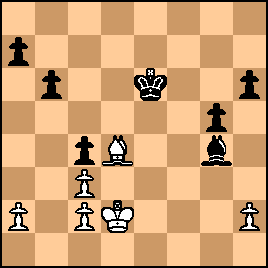
click for larger view |
|
| Jul-22-24 | | Mathematicar: Where are Capablanca's notes from? |
|
| Jul-23-24 | | sneaky pete: From <My Chess Career>, first published in 1920. JRC dates the game January or February 1914. This discrepancy may have to do with the use of the Julian calender in the Russian Empire. |
|
| Aug-21-24 | | Mathematicar: <sneaky pete>, thanks, sorry for the late reply. Maybe one of the greatest discovery from Capablanca's two famous books is the principle which says that "when the opponent has a Bishop, keep your Pawns on squares of the same colour as your opponent's Bishop". Of course, this is your usual blockade. But, for some reason, I took this advice too superficially. It sounds trivial, but in many endgame positions, one should actually keep the Pawns on squares of the opposite colour of the opponent's Bishop so that they cannot take them. I remember Agadmator commenting that, in Capablanca's game against Banks at Rice Memorial 1916, "Capablanca is keeping the pawns on the light squares so that Banks cannot take them" or something in those lines. I throw a new, fresh look at the game yesterday and this statement is false. Capablanca simply didn't waste time to block opponent's Bishop because he had a direct attack against the White's position which lead to a won endgame being a pawn up. Anways, thanks for replying. |
|
Aug-22-24
 | | keypusher: <keypusher: 21 g4 looks like a really bad move. Has anyone ever seen any commentary on it?> The SF evaluation drops immediately from about -0.5 to about -1.5 after it is played. Capablanca has a bad habit of skipping over his opponent's evident errors. 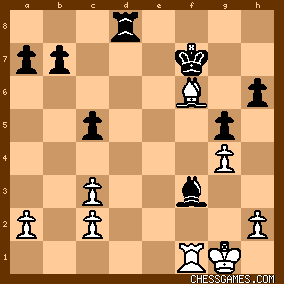
click for larger view27....Rd1 is a pretty move, but interestingly the engine prefers 27....Kxf6 28.Rxf3+ Ke5 with what it evaluates as a winning rook ending (if 29.Rf5+ Ke4 30.Rxc5? Kf3). But then we wouldn't have had the bishop-of-opposite-colors ending.... <andrea volponi: 30-Ke1!(=) c4- Kd2 Ke6 -Bd4 b6 con probabile patta .> In very deep searches (60+ ply) SF puts its pawns on a6, b5, c4, and tries to invade on the K-side with its king. It picks up the pawn on c2, so it has majorities on both sides of the board. 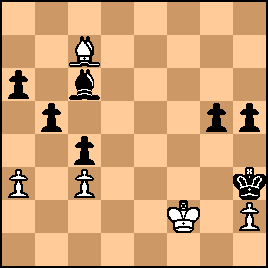
click for larger viewAfter a lot of (to me) incomprehensible maneuvering, it winds up in a position like this: 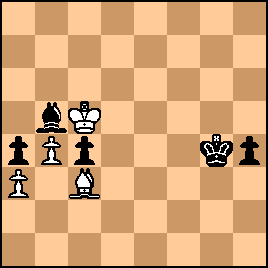
click for larger view...which is winning, even with White to move: 1.Kxb5 h3 2.Be5 c3, etc. So Capablanca was probably right to say that the ending was won after 29....Bxg4. But 30.a4 made matters a lot easier for him. |
|
Aug-23-24
 | | keypusher: From the position in the diagram in the earlier post (W: Kf2, Bc7, P h2, c3, a3; B: Kh3, Bc6, P h5, g5, c4, b5, a6, White to move). Black marches his king to b3(!), gets a passed pawn on the kingside, and eventually wins a pawn on the queenside, after which the win is straightforward. 44. Kg1 Bd7 45. Kh1 Be8 46. Kg1 Bc6 47. Bd8 Kg4 48. Kf2 Kf4 49. Ke2 g4 50. Kf2 Ke4 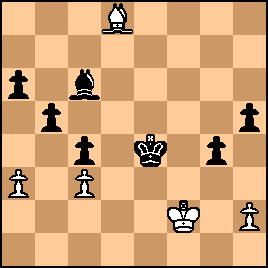
click for larger view51. Kg3 (if White tries to prevent the king from going to the queenside by playing Ke2 and maneuvering his bishop, Black eventually plays ...a5, ...b4, axb4 a4 as in the diagram from my previous post) 51....Kd3 52. Ba5 Kc2 53. Bb4 Kb3 54. Kf4 Be8 55. Ke3 h4 56. Kf2 Bd7 57. Kg1 g3 58. hxg3 h3 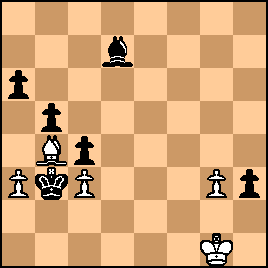
click for larger view59. g4 (if White shuffles his king around instead of giving back the pawn, Back plays ...Bg4, ...Ka4, ...a5, and ...Kb3 winning one of the queenside pawns. If White attacks the a-pawn with his bishop while the king is on b3, then ...b4! and Black will eventually win the bishop with his c-pawn, as in the game, or just ...a4 and one of White's queenside pawns will go. In the long run White's g-pawn is doomed.) 59....Bxg4 60. Kf1 Ka4 61. Kf2 a5 62. Be7 Kb3 and now White loses one of the queenside pawns as per the previous note. If 63.Bc8 either ...a4 or ...b4 wins. |
|
| Dec-27-24 | | andrea volponi: 30 Ke1! c4 -Kd2 Ke6 -Bd4 b6 -Bg7 h5 -Ke3 Bf5 -Bh6 Kf6 -Bf8 Bxc2 -Bd6 Kf5 -a3 Kg4 -Bb8 a6 -Kf2 Kh3 -Bc7 b5 -Kg1 Be4 -Bd8 Kg4 -+ il nero vince creando un pedone passato. |
|
 |
 |
|
< Earlier Kibitzing · PAGE 4 OF 4 ·
Later Kibitzing> |





